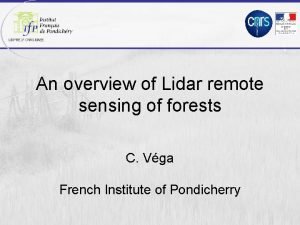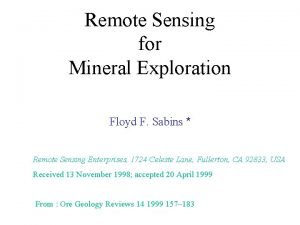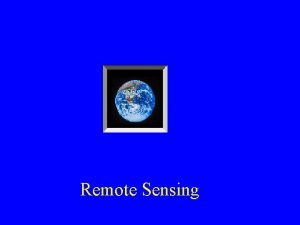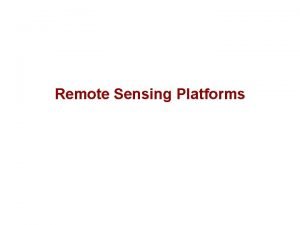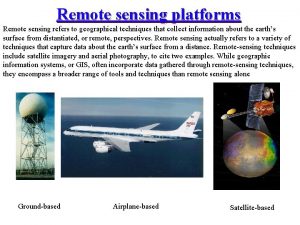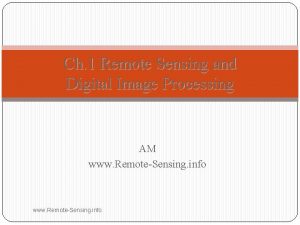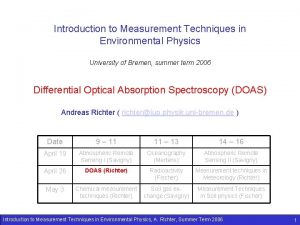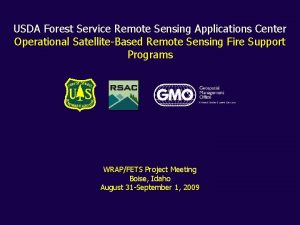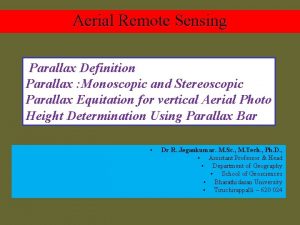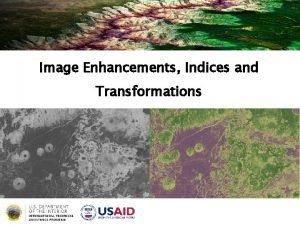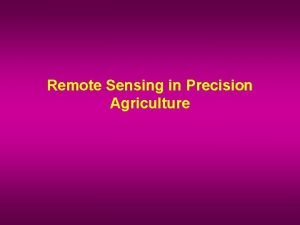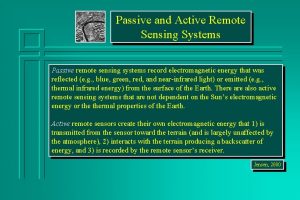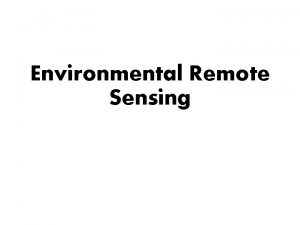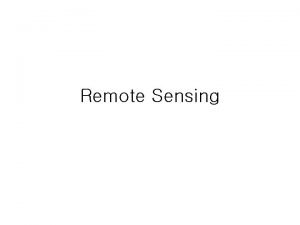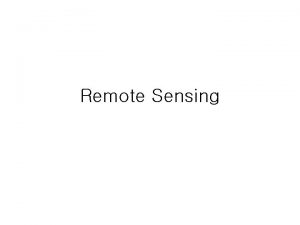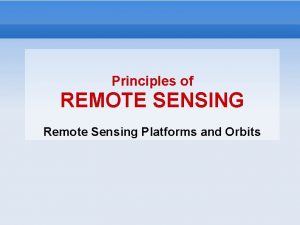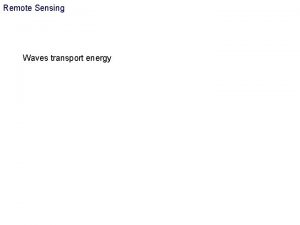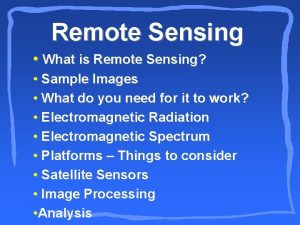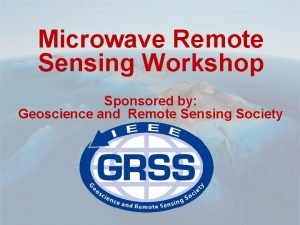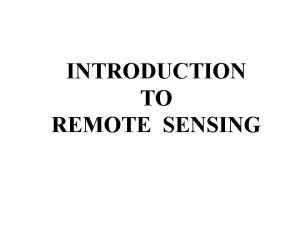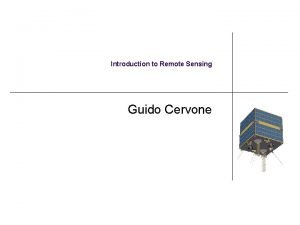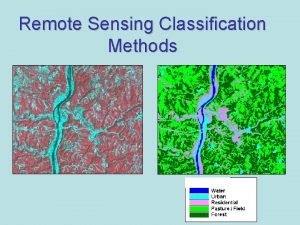Principles of REMOTE SENSING Sensors Sensors A sensor













- Slides: 13

Principles of REMOTE SENSING Sensors

Sensors A sensor is a device that measures and records electromagnetic energy. Sensors can be divided into two groups: 1. Passive sensors Passive Sensors depend on an external source of energy, usually the Sun, and sometimes the Earth itself. The oldest and most common type of passive sensor is the photographic camera. 2. Active sensors have their own source of energy. Measurements by active sensors are more controlled because they do not depend upon varying illumination conditions. Active sensing methods include radar (radio detection and ranging), Lidar (light detection and ranging) and sonar (sound navigation ranging), all of which may be used for altimetry as well as imaging.

Passive vs. Active Sensors

1. Passive sensors The gamma-ray spectrometer measures the amount of gamma rays emitted by the upper soil or rock layers due to radioactive decay. The energy measured in specific wavelength bands provides information on the abundance of (radioisotopes that relate to) specific minerals. Therefore, the main application is found in mineral exploration. Gamma rays have a very short wavelength on the order of picometers (pm). Because of large atmospheric absorption of these waves, this type of energy can only be measured up to a few hundred meters above the Earth’s surface.

Passive sensors……continue Aerial camera The (digital) camera system, lens and film (or CCD), is mostly found in aircraft for aerial photography. Low orbiting satellites and NASA Space Shuttle missions also apply conventional camera techniques. The film types used in the camera enable electromagnetic energy in the range between 400 nm and 900 nm to be recorded. Video cameras are frequently used to record data. Most video sensors are only sensitive to the visible spectrum, although a few are able to record the nearinfrared part of the spectrum. A recent development is the use of thermal infrared video cameras. Until recently, only analogue video cameras were available. Today, digital video cameras are increasingly available, some of whichareappliedinremotesensing. Analogue false colour video image of De Lopikerwaard, the Netherlands. Courtesy of Syntoptics.

Passive sensors……continue Multispectral scanner Ø An instrument is a measuring device for determining the present value of a quantity under observation. A scanner is an instrument that obtains observations in a point-by-point and line-by-line manner. Ø The multispectral scanner is an instrument that measures the reflected sunlight in the visible and infrared spectrum. A sensor systematically scans the Earth’s surface, there by measuring the energy reflected by the viewed area. This is done simultaneously for several wavelength bands, hence the name multispectral scanner. A wavelength band or spectral band is an interval of the electromagnetic spectrum for which the average reflected energy is measured. Ø For example, reflection characteristics in the range of 2 µm to 2. 5 µm (for instance, Landsat TM band 7) may give information about the mineral composition of the soil, whereas the combined reflection characteristics of the red and near infrared bands may tell something about vegetation, such as biomass and health. Landsat-5 Thematic Mapper image of Yemen, 1995.

Passive sensors……continue Imaging spectrometer or hyperspectral imager Ø The principle of the imaging spectrometer is similar to that of the multispectral scanner, except that spectrometers measure many (64– 256), very narrow (5 nm to 10 nm) spectral bands. This results in an almost continuous reflectance curve per pixel rather than the limited number values for relatively broad spectral bands of the multispectral scanner. Ø The spectral curves depend on the chemical composition and microscopic structure of the measured material. Imaging spectrometer data, therefore, can be used, for instance, to determine the mineral composition of the Earth’s surface, the chlorophyll content of surface water, or the total suspended matter concentration of surface water Total Suspended Matter concentration data of the North Sea derived from the Sea. Wi. FS sensor onboard the Orb. View-2 satellite.

Passive sensors……continue Thermal scanner Ø Thermal scanners measure thermal data in the range of 8 µm to 14 µm. Wavelengths in this range are directly related to an object’s temperature. For instance, data on cloud, land sea surface temperature are indispensable for weather forecasting. For this reason, most remote sensing systems designed for meteorology include a thermal scanner. Night-time airborne thermal scanner image of a coal mining area affected by underground coal fires.

Passive sensors……continue Microwave radiometer Ø Long wavelength EM energy (1 cm to 100 cm) is emitted from the objects on, or just below, the Earth’s surface. Every object with a temperature above the absolute temperature of zero Kelvin emits radiation, called the blackbody radiation Ø Natural materials may emit radiation that is some what lower than the ideal case of a black body, which is demonstrated by an emissivity smaller than 1 A microwave radiometer records this emitted radiation of objects. Ø Passive microwave radiometer data can be used in mineral exploration, soil mapping, soil moisture estimation Map of the Iberian Peninsula showing the long-term trend in soil moisture change over a 10 -year period.

2. Active sensors Laser scanner Ø A very interesting active sensor system, similar in some respects to radar, is lidar (light detection and ranging). A lidar transmits coherent laser light, at a certain visible or near-infrared wavelength, as a series of pulses (thousands per second) to the surface, from which some of the light reflects. Travel time for the round-trip and the returned intensity of the reflected pulses are the measured parameters. Lidar instruments can be operated as profilers and as scanners on airborne and spaceborne platforms, day and night Ø Laser scanning produces detailed, highresolution, Digital Terrain Models (DTM) for topographic mapping Digital Terrain Model (5 m grid) of the marl-pit on the Sint Pietersberg, the Netherlands.

Active sensors……continue Imaging radar Ø Radar (radio detection and ranging) instruments operate in the 1 cm to 100 cm wavelength range. Different wavelength bands are related to particular characteristics of the Earth’s surface. The radar backscatter is influenced by the emitted signal and the illuminated surface characteristics Ø Since radar is an active sensor system and the applied wavelengths are able to penetrate clouds, it can acquire images day and night and under all weather conditions, although the images may be affected somewhat by heavy rainfall. ERS-1 SAR image of the Mahakam Delta, Kalimantan. The image shows different types of land cover.

Active sensors……continue Bathymetry and Side Scan Sonar Ø Sonar stands for sound navigation ranging. It is a process used to map sea floor topography or to observe obstacles underwater. It works by emitting a small burst of sound from a ship. The sound is reflected off the bottom of the body of water. The time that it takes for the reflected pulse to be received corresponds to the depth of the water. More advanced systems also record the intensity of the return signal, thus giving information about the material on the sea floor. Ø In its simplest form, the sonar looks straight down, and is operated very much like a radar altimeter. The body of water will be traversed in paths like a grid, and not every point below the surface will be monitored. The distance between data points depends on the ship’s speed, the frequency the measurements, and the distance between the adjacent paths.

References Kerle et al. , 2004. PRINCIPLES OF REMOTE SENSING: An introductory textbook. The International Institute for Geo-Information Science and Earth Observation (ITC), Enschede, The Netherlands, 250 p. https: //en. wikipedia. org/wiki/Gamma-ray_spectrometer#/media/File: Grsradiationmed. jpg https: //coastal. er. usgs. gov/capabilities/shipboard/sonar/bathysonar. html
 Lidar
Lidar Remote sensing aphg
Remote sensing aphg Advantages of remote sensing
Advantages of remote sensing Microwave remote sensing lecture notes
Microwave remote sensing lecture notes Remote sensing platforms
Remote sensing platforms Ifov and fov in remote sensing
Ifov and fov in remote sensing Limitations of remote sensing
Limitations of remote sensing Remote sensing physics
Remote sensing physics Remote sensing applications center
Remote sensing applications center Process
Process Image parallax in remote sensing
Image parallax in remote sensing Remote sensing
Remote sensing Remote sensing in precision agriculture
Remote sensing in precision agriculture Active passive remote sensing
Active passive remote sensing
